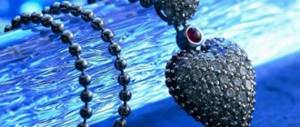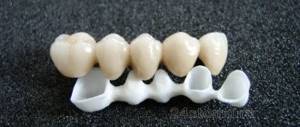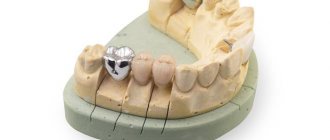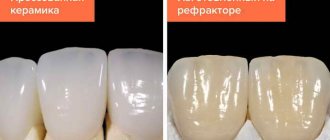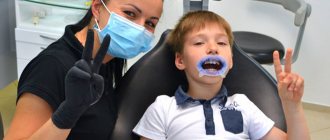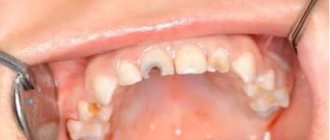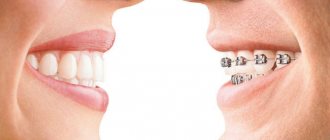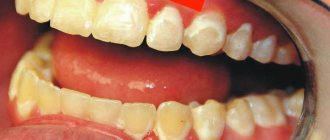Safety of MR Imaging in Patients with Dental Appliances and Devices
An MRI scanner generates the powerful magnetic fields needed to produce images. Metals interact with magnetic fields in different ways. As a result of this interaction, a number of effects arise that affect the results of the examination - dark spots or so-called artifacts appear on the images, which can complicate or make diagnosis impossible, metal products can heat up or move under the influence of a magnetic field. The degree of this influence depends on what metal was used for the manufacture of metal structures for dental purposes.
Artifacts
Most often in dentistry, inert metals are used - titanium, gold and its alloys, zirconium, nickel, zinc, chromium, copper, silver, iron (stainless steel) - which do not interact with living tissues. Depending on the ability of these materials to cause artifacts, a distinction is made between MRI-compatible and non-MRI metals.
MRI-compatible metals that cause no or minimal artifacts include zirconium (the metal from which dental crowns are made), silver, zinc, copper alloys, titanium and its alloys, gold and its alloys, nickel and its alloys. Stainless steel, alloys containing large amounts of chromium and cobalt are not compatible with MRI and cause artifacts that complicate diagnosis. You can find out detailed information about the composition of the materials used to make dental structures from your dentist.
Heating the metal
The magnetic fields generated by an MRI machine can cause heating of metal products, up to temperatures sufficient to cause a burn. However, this is only true for metal objects that are on the surface of the patient's body - which is why it is recommended to remove all metal objects, jewelry, piercings and jewelry before the examination. Metal crowns, dental pins, implants, and dentures are less susceptible to this effect - studies on the safety of MRI in the presence of metal in the mouth have found that the heating of such products during research does not exceed 2-3 degrees Celsius. Therefore, MRI of the head or internal organs is a safe procedure for the patient, even in the presence of dental structures.
Displacement of metal structures for dental purposes
The magnetic fields generated during magnetic resonance imaging are capable of attracting metal objects made from magnetic metals, giving them significant acceleration. It is for this reason that before performing an MRI of the brain, spine or any other parts of the body, it is strictly forbidden to carry any metal objects on you. Otherwise, a piece of metal flying into the tomograph magnet can cause serious injury. In this case, is it possible to do an MRI with metal crowns on the teeth, with pins or braces? It is possible, since the mass of such products does not exceed several grams, and the structure itself is firmly fixed in the oral cavity. The exception is braces, dental crowns, bridges and dentures made of stainless steel. Removable structures must be removed before performing the procedure - this will not only make the examination safer, but will also improve the quality of the resulting images. If the structure is not removable, it is recommended to consult a dentist to check the strength of the fastening and prevent the product from moving.
Crowns on teeth and MRI of the head
The presence of metal or metal-containing crowns and/or pins in patients is an absolute contraindication to MRI of the head, brain, neck and chest.
The type of metal used to make the crowns does not play a big role. It is not known for certain how metal dental crowns will behave inside a magnetic field. Gold crowns are not as dangerous for MRI, but they can cause serious interference, which degrades the quality of the images.
In addition to crowns, there may be pins in the patient's mouth. They are a metal screw or rod installed in the root of the tooth. Titanium, brass, steel, and copper are most often used for their manufacture. The purpose of the pins is to strengthen the dilapidated tooth. They are attached to the dental canal using threads or filling material. Often, patients themselves do not know what material they are made of and how their pins are secured, so in most cases there is no risk in performing MRI on such clients. An exception may be studies using magnetic resonance of those parts of the body that are located away from the head: the abdominal cavity and retroperitoneal space, pelvis, lower extremities.
With which implants is MRI of the brain contraindicated?
Implants are not a contraindication for brain MRI, since they are mainly made of titanium. Titanium and its alloys are compatible with MRI and result in virtually no artifacts in images. However, if non-removable stainless steel dental products are installed in the oral cavity, artifacts can cover most of the cervical spine and head, making the diagnosis of diseases of the brain and neck uninformative. If this happens, such research will not be paid for. You can obtain more detailed information from the doctors of our medical center.
| MRI of the head and neck, which shows |
| Stroke on MRI of the brain |
| MRI of the pituitary gland with contrast, what does it show? |
| MRI of the brain with contrast, how is it done? |
| Decoding MRI of the brain |
| MRI of cerebral vessels, which shows |
How does a patient with metal ceramics feel during the procedure?
During a diagnostic examination in the presence of metal-ceramic structures, the patient will not experience any discomfort, much less acute pain or other painful sensations. The patient's life is also in perfect order and nothing threatens her.
MRI is successfully used in diagnosing a wide variety of diseases, including examining the upper and lower jaws for the presence of any pathologies
If for one reason or another you are denied an examination, this will be due to the fact that your metal-ceramic crowns will greatly distort the final result. This will happen due to the resonance of the metal elements of the dental structure and the magnetic field of the tomograph. As a result, the doctor will either not be able to see the tissues he needs, or marks will appear on them that will give a false diagnosis.
Attention! Patients with metal-ceramic crowns are often denied examination due to the high cost of MRI. Since it is difficult to predict the final result, some laboratories prefer to refuse treatment to the patient, especially when it is carried out on a budgetary basis, when it is not the patient who pays, but the clinic.
How do metal parts react when examined in a tomograph?
There is a stereotype that tomography cannot be done with metal braces. Reviews from some patients indicate that the structure is attracted by a magnet, heats up, emits harmful substances and can completely deteriorate. These myths are supported by people's imagination, since none of the hypotheses have been confirmed.
On a note!
A person with braces does not feel anything unusual during an MRI of the head. The examination is the same as without orthodontic construction. Nothing gets hot, explodes or gets damaged.
Should you tell your doctor that you have dental implants?
Dental replacement implants are made primarily from titanium. This is a paramagnetic material that does not resonate with a magnetic tomograph. But this does not mean that there are no restrictions on the examination.
To avoid having to undergo an MRI twice, notify your doctor about the implant so that he can change the machine settings
The diagnostician must be informed about artificial teeth for two reasons:
- Titanium is capable of distorting the picture. Yes, the metal does not heat up and does not move. But it can create minor interference. In order not to undergo an expensive procedure twice, it is better to immediately notify the doctor about the implant - he will change the settings of the device.
- The titanium pin is not the only element of the implant. In addition to the rod itself, there is also an abutment (gum former) and a crown. They are made from ceramics or various types of metal and then lined with porcelain.
Therefore, patients are always asked about the presence of implants at least twice: when giving a referral and immediately before diagnosis.
An alternative method of examination with braces is CT
Computed tomography is an alternative to magnetic scanning. The main difference between them is that MRI uses magnetic influence, while CT uses X-rays.
You can do a CT scan with braces. Orthodontic treatment is not a significant contraindication for examination. The only nuance that experts take into account is the material used to make the correction system. During an x-ray, it can be recorded by the system. Therefore, when interpreting the results, it is necessary to pay attention to the error. Automatic interpretation of results may be distorted and show a pathological process where it actually does not exist.
What can replace MRI?
If a patient is contraindicated to undergo magnetic resonance imaging, and he does not want to remove metal-ceramic crowns, you can try to find an alternative. To do this, the following methods can be used, which can be found in the table.
| Procedure | Information content |
Computer diagnostics | Second place in terms of information content |
Ultrasonography | Relatively effective, sometimes requires confirmation with MRI |
Biochemical tests | Effective in some cases |
| Tests under special conditions (endurance, vestibular simulator, etc.) | Not very informative, used only in combination |
General tests | It is advisable to use only in combination. |
Attention! Despite the possibility of using an alternative option, only magnetic resonance therapy can give the most accurate result, identifying even the slightest abnormalities that are not yet visible on ultrasound and any other tests.
Regardless of how many metal-ceramic crowns you have and what part of the body you are undergoing an MRI procedure for, you should always warn your doctor about the presence of a foreign body in your teeth.
You should definitely notify your doctor about the presence of metal-ceramic crowns.
If it is impossible to undergo an examination, the specialist will prescribe other procedures that can give an accurate picture of the state of health. If magnetic resonance imaging cannot be done, a computer diagnostic method is usually used.
Patient misconceptions about the effect of magnets on braces
Some patients refuse the procedure because they consider MRI and a retainer (braces) to be incompatible. Main misconceptions:
- if you do a magnetic examination with an orthodontic design, the result will be unreliable, and the examination itself will be useless;
- the magnetic tomography device affects the tension force of the corrective arc, after which the staples become useless;
- when exposed to a magnetic field, the metal releases toxic substances that are dangerous to humans;
- when manipulated, the plates heat up and can peel off from the tooth;
- a magnet can attract locks and arches, so doing an examination is dangerous.
Important!
None of the assumptions has a scientific evidence base, so they are all considered patient misconceptions. If there are concerns about the effectiveness and safety of this diagnosis, it is worth listening to the opinions of several specialists.
